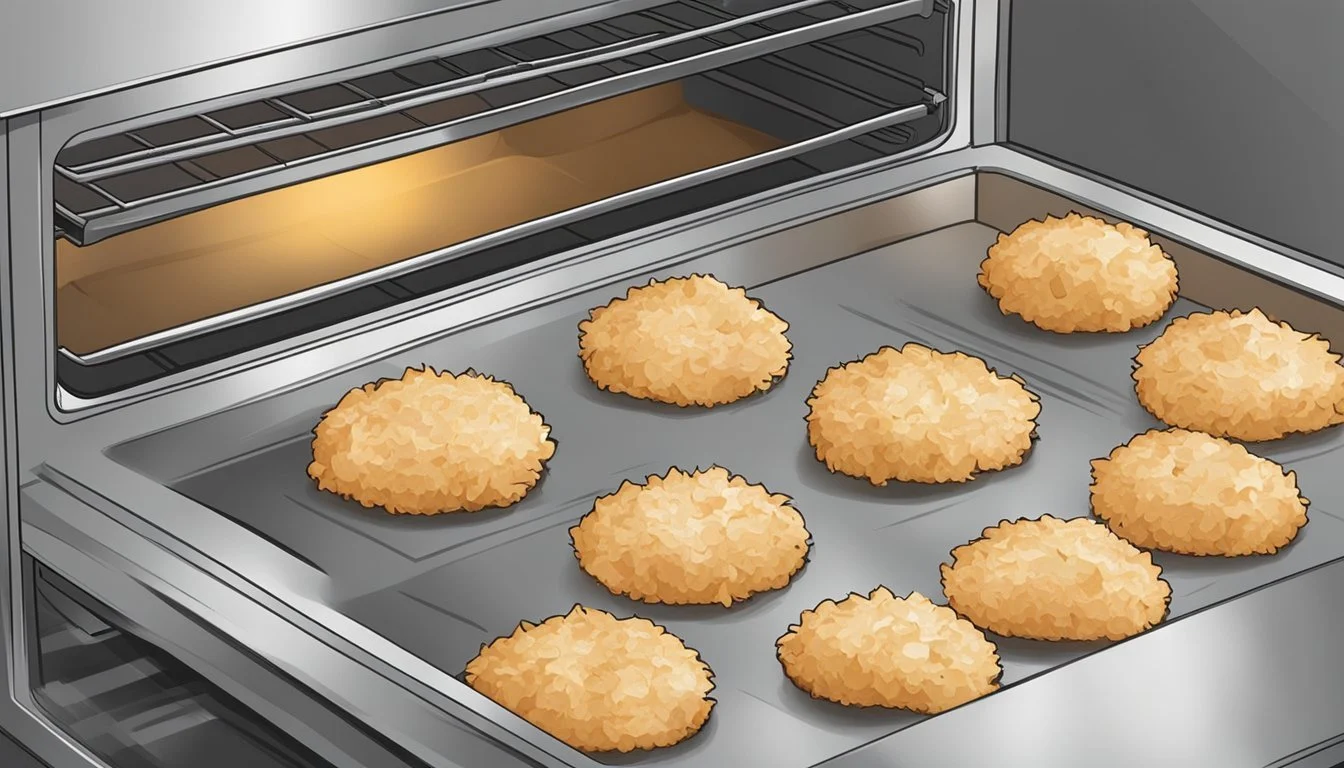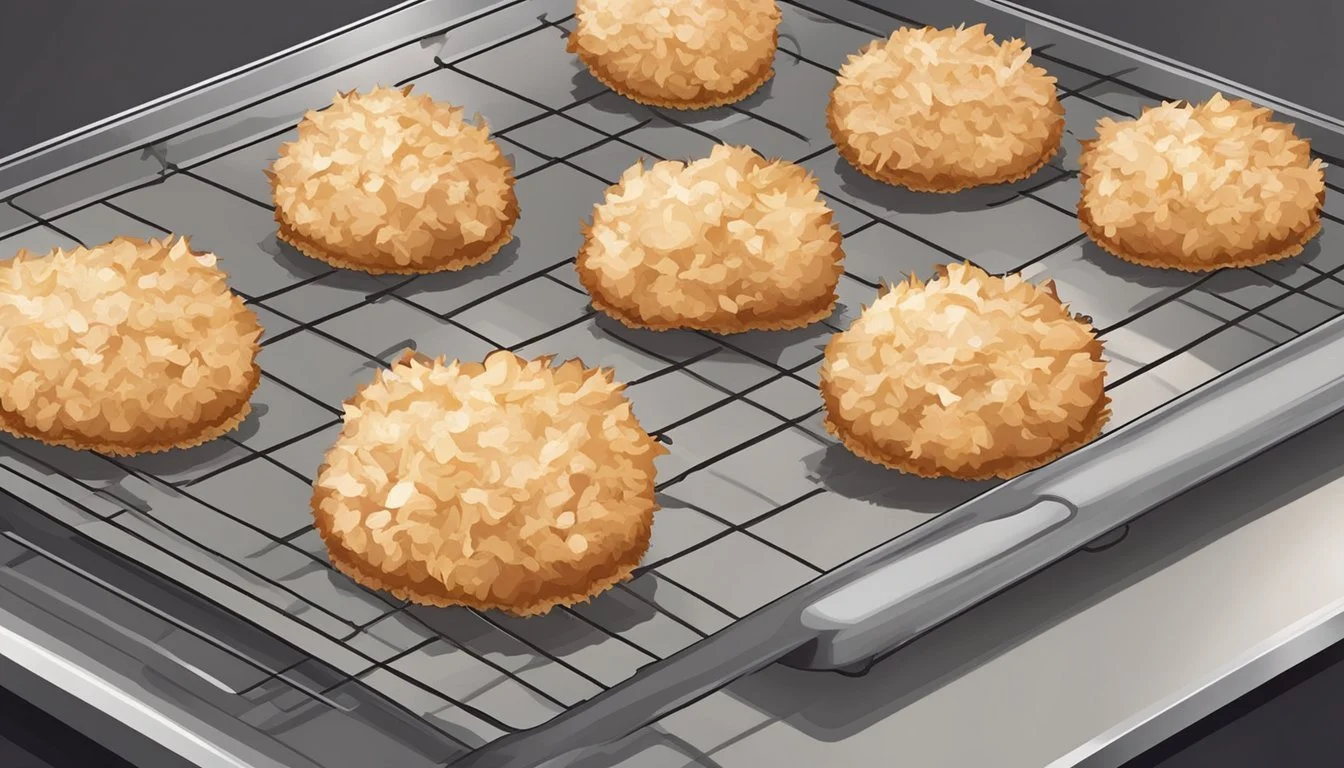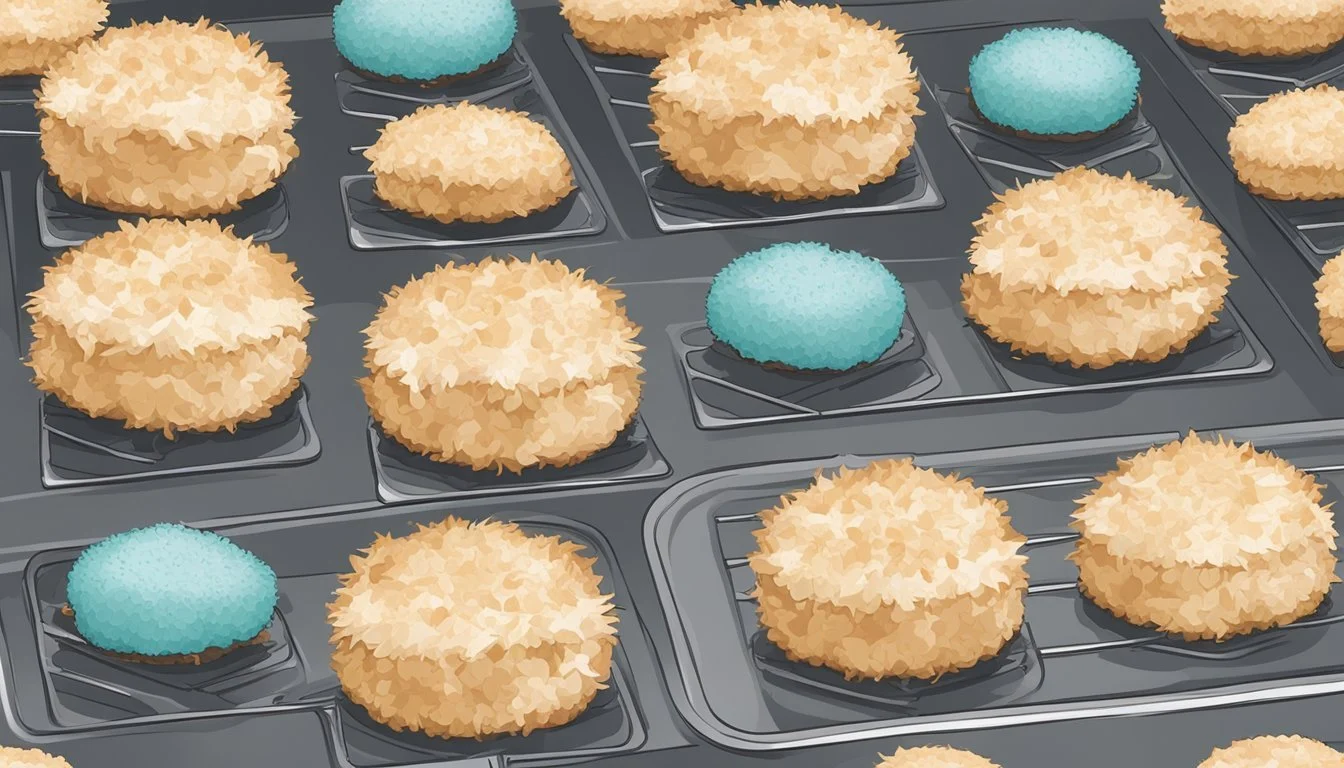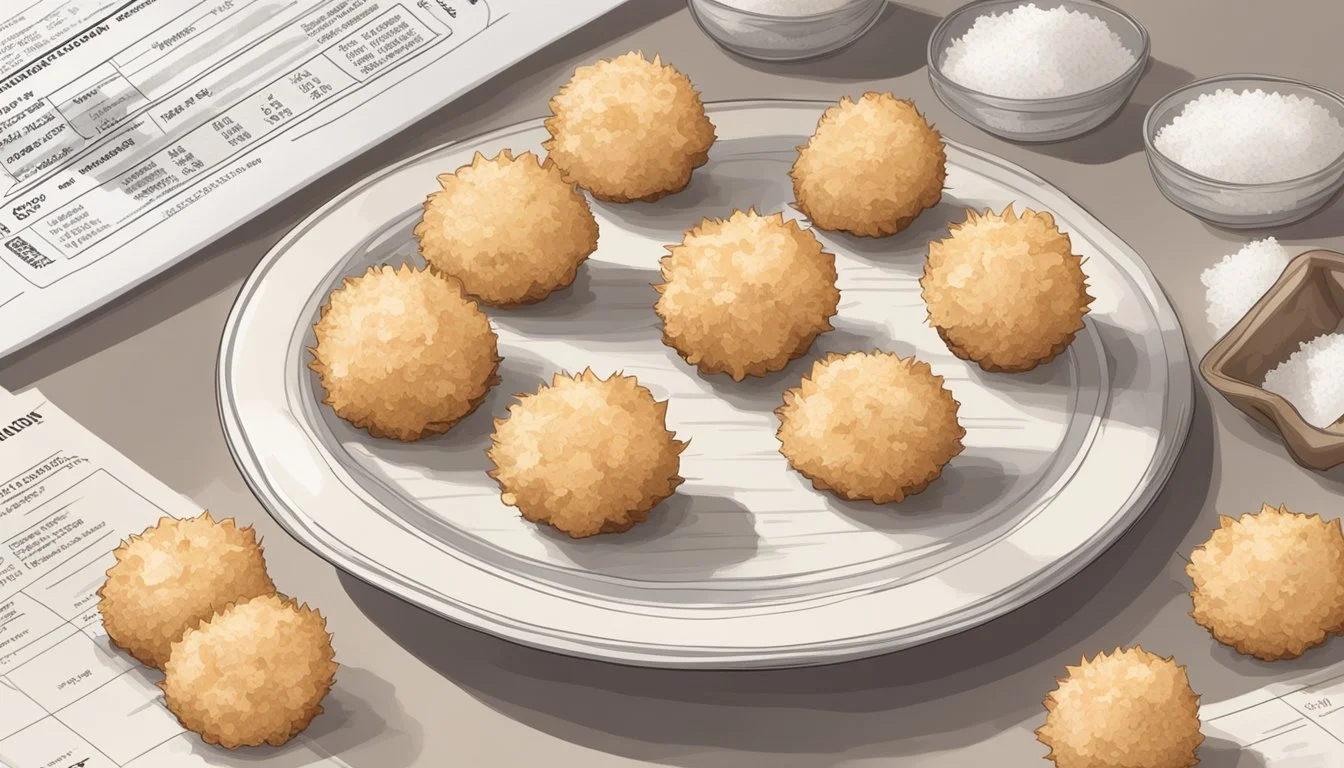How to Reheat Coconut Macaroons
Simple and Effective Methods
Coconut macaroons are a delightful treat with their chewy centers and crispy edges. Reheating these delicious cookies without losing their texture can be a challenge, but it's entirely possible with the right method. To reheat coconut macaroons, preheat your oven to 300°F (149°C), place the macaroons on a baking sheet lined with parchment paper, and heat them for 3-5 minutes.
This gentle reheating method ensures that the macaroons regain their freshly baked taste without becoming overcooked. The goal is to restore their toasty exterior while keeping their soft, moist interior intact.
Taking the time to reheat them correctly makes a significant difference in enjoying these coconut treats at their best. For those looking to savor their macaroons as if they were just baked, this quick process is the key.
Understanding Coconut Macaroons
Coconut macaroons are a delightful treat known for their moist, chewy interior and crispy exterior. Understanding what makes them unique involves examining their key ingredients and distinguishing them from similar confections like macarons.
Key Ingredients
Coconut macaroons are made with simple ingredients that ensure their characteristic texture and flavor. The primary ingredient is shredded coconut, which gives the macaroons their distinct chewy and moist consistency. Often, sweetened coconut is used for added sweetness.
Egg whites play a crucial role in binding the ingredients together and providing structure. They are whipped to create volume and lightness in the mixture. Another essential ingredient is sweetened condensed milk, which adds a rich, milky flavor and ensures the macaroons remain moist.
A touch of vanilla extract enhances the overall flavors, adding a subtle depth. Some recipes include sugar for extra sweetness and a firmer texture. For those looking to add a twist, chocolate can be incorporated, either drizzled on top or mixed into the batter.
Macaroon vs. Macaron
Though similar in name, macaroons and macarons are quite different. Coconut macaroons are dense, chewy, and primarily made with shredded coconut, egg whites, and sweetened condensed milk. They have a rustic appearance and are often dipped in or drizzled with chocolate.
Macarons, in contrast, are delicate sandwich cookies made from almond flour, powdered sugar, and meringue. They come in a variety of colors and flavors, featuring a smooth, crisp shell and a soft, chewy interior. The filling for macarons ranges from buttercream and ganache to jam, offering a wide array of taste experiences.
While both are beloved treats, the coconut flavor and simple ingredients of macaroons set them apart from the refined elegance of macarons. Understanding these differences helps enhance appreciation and enjoyment of both desserts.
Preparation Techniques
Proper preparation is essential to ensure that coconut macaroons are both delicious and have the desired texture. Key steps include mixing the ingredients thoroughly and baking them correctly.
Mixing the Ingredients
Start by combining the dry ingredients. In a large bowl, mix shredded coconut, a pinch of salt, and sweetened condensed milk. For best results, use pure vanilla extract to enhance the flavor.
Next, beat egg whites to stiff peaks using an electric mixer. This helps create a light and airy texture. Ensure the mixer is on high speed until the egg whites form medium-firm peaks. Carefully fold these beaten egg whites into the coconut mixture to maintain the airiness.
Baking the Macaroons
Preheat the oven to the appropriate temperature, typically 325°F (163°C). Lining a baking sheet with parchment paper prevents sticking and makes for easy clean-up. Use a spoon or a small scoop to shape the macaroons into uniform mounds on the baking sheet.
Bake the macaroons for about 20 minutes, or until they are golden brown on the outside but still soft inside. Avoid overbaking, as it can result in a dry texture. Once baked, transfer the macaroons to a wire rack to cool completely.
Properly prepared and baked macaroons will have a crispy exterior and a chewy center, capturing the essence of this delightful, gluten-free treat.
Reheating Coconut Macaroons
Reheating coconut macaroons properly ensures they retain their chewy texture and toasty exterior. Here’s how to reheat them using different methods, while avoiding over-baking and maintaining their moisture and texture.
Best Reheating Methods
Oven Method: Preheat the oven to 300°F (149°C). Place the macaroons on a baking sheet lined with parchment paper. Bake for 3-5 minutes. This method warms the macaroons evenly and revives their toasty exterior without altering the soft inside.
Microwave Method: Microwaving is faster but can be tricky. Place macaroons on a microwave-safe plate and cover with a damp paper towel. Heat on medium for 15-20 seconds. Check if warm; if not, heat in 5-second increments.
Both methods have their merits. The oven method is best for multiple macaroons, while the microwave is quick and suitable for one or two treats.
Avoiding Over-Baking
The key to reheating coconut macaroons without over-baking lies in careful timing and temperature management. Using high heat or long durations causes the macaroons to dry out or burn.
Oven Timing: Stick to the 3-5 minute range at 300°F. Preheating is crucial to ensure consistent temperature. Always monitor closely; visual and tactile checks ensure they are warm but not browning further.
Microwave Timing: Short intervals are crucial here. Heating in 5-second increments after the initial 15-20 seconds prevents over-drying. The damp paper towel helps distribute steam, keeping the macaroons moist.
Avoid using a too high setting on the microwave or oven. High heat not only risks burning but also causes a loss of the desired chewy texture.
Maintaining Moisture and Texture
Maintaining the right texture in reheated macaroons is essential. Here are tips:
Storage Prior to Reheating: Store macaroons in an airtight container at room temperature. This prevents them from becoming too dry or stale before reheating.
Oven Method: Reheating at 300°F preserves moisture as it’s gentle on the delicate makeup of the macaroons. Lined parchment ensures they don’t stick or get overly crispy.
Microwave Method: The damp paper towel is crucial. It provides necessary moisture, ensuring the macaroons remain chewy and do not dry out.
Reheat only what is needed. Repeated heating and cooling cycles negatively affect texture and taste.
By following these methods and tips, reheating coconut macaroons can be done effectively, retaining their delightful texture and flavor.
Improving and Varying Flavor
For those looking to enhance the flavor of coconut macaroons, there are numerous ways to incorporate different tastes and sweetness levels. Some popular methods include adding chocolate and experimenting with different sweeteners and extracts.
Incorporating Chocolate
Adding chocolate can elevate coconut macaroons, enhancing their taste and providing a delightful contrast with the sweetness of the coconut. One common approach is to use a dark chocolate drizzle.
Melt dark chocolate in a microwave-safe bowl or over a double boiler until smooth. Dip the bottom of each macaroon into the melted chocolate or drizzle the chocolate over the top. This adds a rich, decadent layer to the treat.
Alternatively, chocolate chips can be folded into the macaroon mixture before baking. This infuses every bite with bursts of chocolate. Using a mix of dark and milk chocolate chips can further vary the flavors and cater to different taste preferences.
Alternative Sweeteners and Extracts
Traditional macaroons often use sugar, but substituting honey or maple syrup can add complexity and depth to the flavor profile. Both honey and maple syrup bring their own unique sweetness and can create a slightly different texture in the finished product.
Almond extract can be used in place of or alongside vanilla extract to introduce a nutty undertone that complements the coconut. For those seeking a hint of warmth, adding a pinch of ground cinnamon to the macaroon mixture can provide a subtle, aromatic spice.
Experimenting with these alternative ingredients allows for a unique twist on classic coconut macaroons, making them even more enjoyable for everyone.
Storing Coconut Macaroons
Proper storage of coconut macaroons ensures they remain fresh and delightful. This guide offers tips for both short-term and long-term storage to help maintain their flavor and texture.
Short-Term Storage Tips
For short-term storage, coconut macaroons should be kept in an airtight container at room temperature. This method retains their crisp exterior and moist interior. Placing them on the counter will keep them fresh for up to a week.
If they need to be stored a little longer, refrigerate them. This helps maintain moisture and texture. Store them in an airtight container or wrap them tightly in plastic wrap before placing them in the fridge. They will stay good for up to two weeks.
Freezing and Long-Term Storage
For long-term storage, freezing is the best option. Allow the macaroons to cool completely after baking. Place them in freezer-safe bags, ensuring all air is squeezed out before sealing. You can also use a freezer-safe, airtight container.
Label each container with the date to keep track of storage time. When ready to enjoy, remove the macaroons from the freezer and let them thaw at room temperature. This gradual thawing helps retain their original texture and taste. Frozen macaroons can be stored for up to three months.
Decorating and Serving Ideas
Adding personal touches and thoughtful presentation elevates coconut macaroons from a simple treat to an impressive dessert. There are numerous ways to enhance their appearance and flavor, making them ideal for various occasions.
Ganache and Toppings
Chocolate Ganache: Drizzling or dipping the macaroons in dark chocolate or white chocolate ganache creates a sophisticated look. Use a spoon or piping bag to ensure an even drizzle.
Sprinkles and Coconut: Top the ganache with sprinkles or sweetened coconut flakes immediately while the chocolate is still wet. This adds both color and texture.
Dried Fruits: Dried cranberries or other dried fruits can be chopped finely and sprinkled over the wet ganache, introducing a tangy contrast to the sweet flavors.
Serving for Occasions
Festive Platters: For a celebration, arrange the macaroons on a large platter with an ice cream scoop for serving a complementary dessert like sorbet or gelato. The contrast between the toasty exterior of the macaroons and the cold, creamy dessert is delightful.
Gift Boxes: Placing the macaroons in decorative boxes lined with parchment paper makes for a charming and thoughtful gift.
Themed Parties: For themed parties, match the toppings to the theme, like orange zest for autumn or colored sprinkles for a birthday celebration.
Nutritional Information
Coconut macaroons provide a sweet treat with notable nutritional profiles. A typical serving of two cookies contains between 100 to 150 calories.
Macronutrients:
Carbohydrates: These macaroons generally have a significant carbohydrate content due to the sweetened coconut and other ingredients.
Protein: They offer a modest amount of protein, often around 1-2 grams per serving.
Fat: Coconut macaroons are known for their high fat content, largely due to the coconut. Expect about 7-9 grams of fat per serving, with saturated fat making up a significant portion.
Additional Nutrients:
Fiber: The shredded coconut contributes to the fiber content, usually providing about 1-2 grams of dietary fiber.
Cholesterol and Sodium: Both levels can vary but are typically low to moderate. Many recipes keep these levels minimal to maintain a healthier profile.
Special Considerations:
Gluten-Free: Coconut macaroons are naturally gluten-free, making them suitable for those with gluten allergies or sensitivities.
Enjoying these treats in moderation aligns with typical dietary guidelines, offering a balance between indulgence and nutritional mindfulness.
Additional Coconut Macaroon Variations
Exploring coconut macaroon variations allows for making dietary adjustments and adding creative twists.
Dietary Adjustments
For those following a vegan diet, replacing egg whites with aquafaba (the liquid from canned chickpeas) can maintain the structure. Unsweetened coconut works well to control sugar levels. Substituting regular flour with almond flour makes the macaroons gluten-free. Using sweetened condensed coconut milk offers a plant-based alternative while keeping a creamy texture, perfect for a dietary-friendly treat.
Creative Twists
Adding unique ingredients can elevate simple macaroons. Combining almond joy flavors, incorporating crushed almonds and bits of dark chocolate, can create a delightful surprise. Using dried fruits like cranberries or apricots adds texture and a hint of tartness. Infusing the mix with citrus zest or flavor extracts like almond or rum can mimic the essence of coconut cream pie or coconut cake. These small adjustments make macaroons versatile for any occasion.
Tips and Tricks
Use Parchment Paper: When reheating coconut macaroons, place them on parchment paper to prevent sticking and ensure even heating.
Opt for Silicone Baking Mats: Silicone baking mats can also be used as an alternative to parchment paper. These mats provide a non-stick surface and help distribute heat properly.
Preheat Properly: Always preheat the oven to the correct temperature. For reheating, 300°F (149°C) is ideal. This low temperature helps to warm the macaroons without over-baking.
Short Baking Time: Heat the macaroons for 3-5 minutes, just enough to refresh their texture without toasting them further.
Check Frequently: Monitor the macaroons closely to avoid over-baking. Over-baking can make them dry and hard.
Storage Matters: Store leftover macaroons in an airtight container to keep them fresh and moist. This method helps retain their soft interior.
Refrigeration: If planning to consume within two weeks, keeping macaroons in the refrigerator can prolong their freshness.
Freezing Tips: For longer storage, freeze macaroons in freezer bags. Make sure to squeeze out any air to prevent freezer burn.
Even Thawing: When defrosting, let macaroons thaw at room temperature to maintain their texture.
Electric Mixer: Use an electric mixer for consistent batter. A well-whisked batter ensures uniformly fluffy and moist macaroons.
Avoid High Temperature: High temperatures can lead to over-baking. Stick to the recommended reheating temperature to avoid compromising the texture.
Following these tips will help in achieving perfectly reheated coconut macaroons with a delicate balance between a crispy exterior and a soft, chewy interior.











